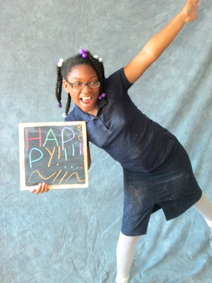
All community projects change along the way. If community project outcomes were exactly the same as planned I would be wondering if community had a voice at all; and the project SPEAK OUT was no different.
As a brief reminder, SPEAK OUT is a community arts based project that uses a series of digital photo workshops to teach upper elementary and middle school kids about photography as an art form and tool for expression. As a result of this project students created photos of themselves to express their personal values.
The biggest change of SPEAK OUT is what the final photos are advocating for. I had planned for students to 'speak out' about issues within their school, what they both valued and needed for a productive learning environment. Instead, photographs became about the values of each student.
This change came naturally and it is what the students were most interested in sharing about.
After thinking about this change I realized that students were in fact speaking out about their schools. When Rayne wrote "Smart" on the chalkboard for her photo she was sharing something that made her significant as an individual. But Rayne also represents many Barclay School students, who did not necessarily participate in the photo workshops. 'Schools should reflect the quality of our students'. In this way, this project came full circle to exhibit the glowing values of Barclay students and, simultaneously advocate for a glowing school to match.
Student artworks will be on exhibit at the 8th Annual Wide Angle Youth Media Festival at the Creative Alliance in Baltimore from May 15th- May 24th, 2013.
As a brief reminder, SPEAK OUT is a community arts based project that uses a series of digital photo workshops to teach upper elementary and middle school kids about photography as an art form and tool for expression. As a result of this project students created photos of themselves to express their personal values.
The biggest change of SPEAK OUT is what the final photos are advocating for. I had planned for students to 'speak out' about issues within their school, what they both valued and needed for a productive learning environment. Instead, photographs became about the values of each student.
This change came naturally and it is what the students were most interested in sharing about.
After thinking about this change I realized that students were in fact speaking out about their schools. When Rayne wrote "Smart" on the chalkboard for her photo she was sharing something that made her significant as an individual. But Rayne also represents many Barclay School students, who did not necessarily participate in the photo workshops. 'Schools should reflect the quality of our students'. In this way, this project came full circle to exhibit the glowing values of Barclay students and, simultaneously advocate for a glowing school to match.
Student artworks will be on exhibit at the 8th Annual Wide Angle Youth Media Festival at the Creative Alliance in Baltimore from May 15th- May 24th, 2013.

 RSS Feed
RSS Feed